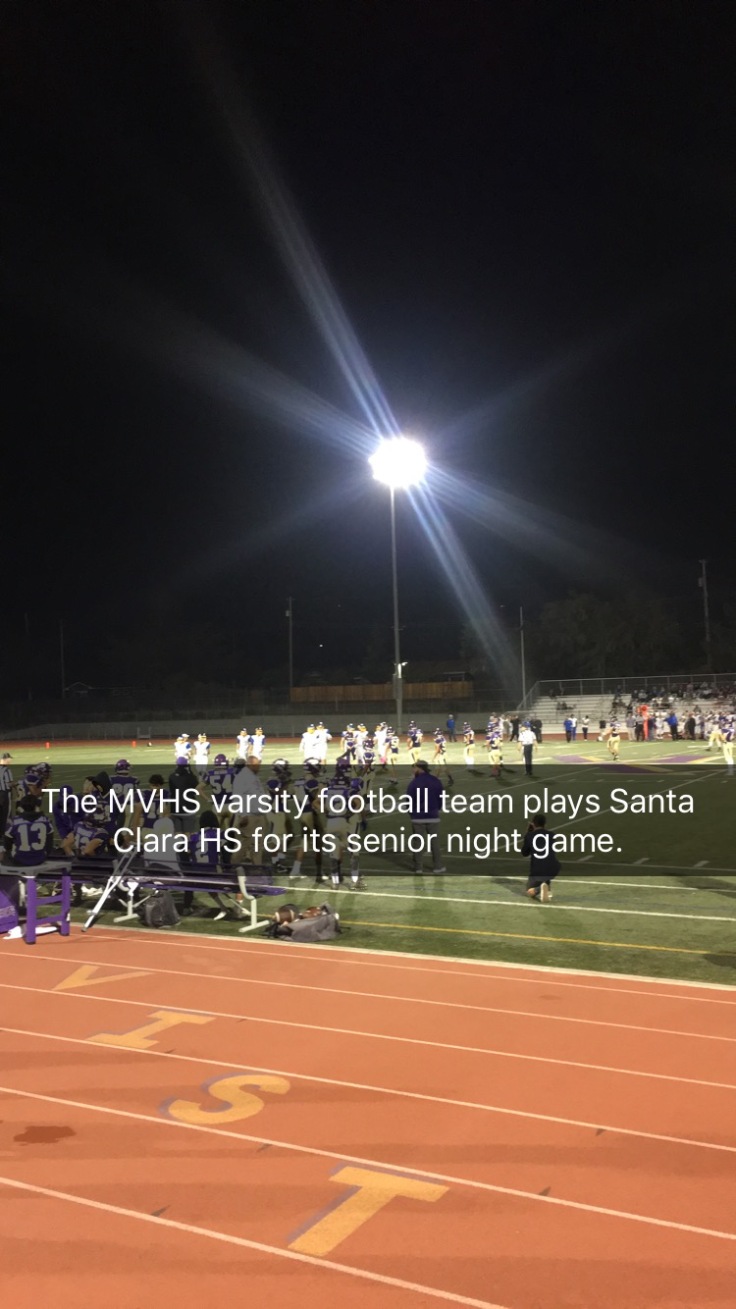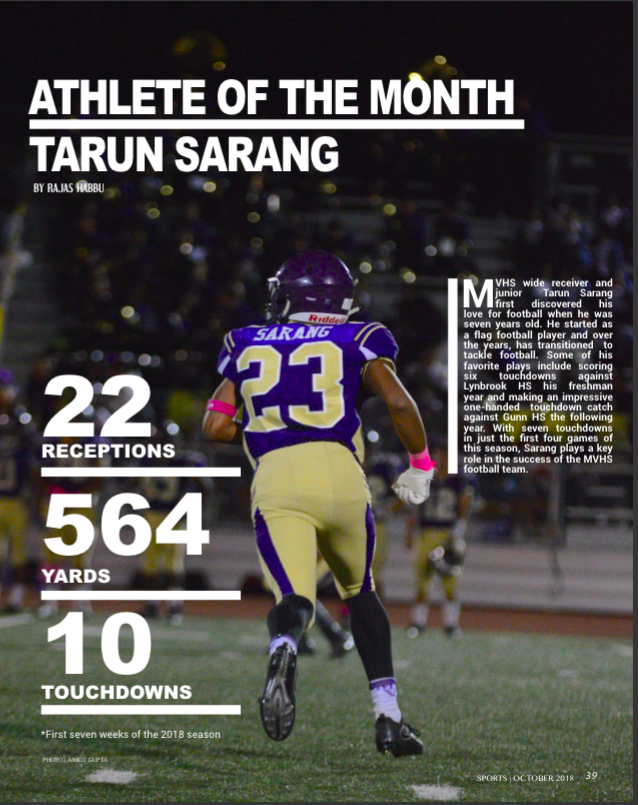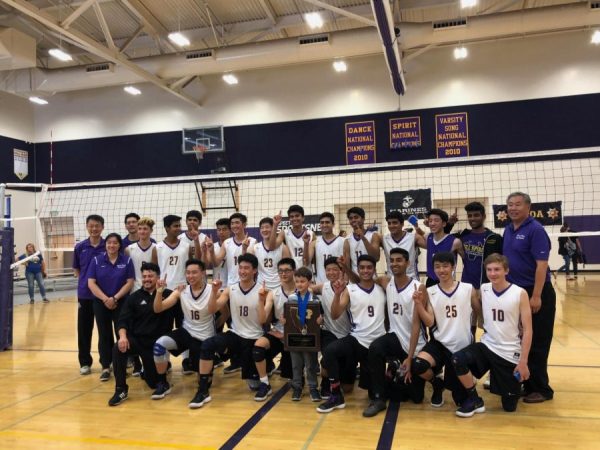Girls Soccer: MVHS edge out Branham HS in low scoring game
After losing their first game of the season 5-0 against Pioneer HS, the Matadors were hoping to bounce back and secure a win in their first home game on Nov. 27. MVHS faced Branham HS, a team that beat them 3-0 in the 2017 season.
The game started off slow, with neither team dominating possession. However, BHS was able to a few breaks through the back line and get a couple shots on target, but they were saved by numerous goalies: sophomore Kira Israni, senior Heather Migdal and junior Catherine Cole.
Due to the poor air quality in the month of November, the Matadors only had a handful practices before their first game. According to coach Jose Vargas, this gave them little time to prepare for their match.
“We didn’t have much [time to practice] since it was smoky,” Vargas said. “Because of that, going into the game, it was a little bit of a mystery, but I thought we were going to play pretty decent.”
In the second half, the Matadors applied more pressure to BHS’ back line. They did this with players like sophomore Hannah Foster who ran up and down field, making herself a threat to the opposing team.
Foster stole the ball around midfield, and dribbled down the left sideline at pace. With her breakaway speed, Foster out ran the BHS defender trying to keep up, and cut inside towards the 18-yard-box. She made her way to just a few yards away from the opposing goal, gathering herself and blasting the ball in the top right corner giving MVHS the lead of 1-0.
“I just saw the opening and I’m used to running down the wing, and beating the defender,” Foster said. “I put it in the middle, and I saw the far post open again, on the net. I shot it there, and it was on point.”
To answer back, Branham HS attempted to break the MVHS back line, but they were stopped by the MVHS defense, with sophomore Shriya Kaushik making key tackles in the box. According to Kaushik, her success on the defensive side was due to the extensive effort the team put forth throughout the game.
“We all thought that we could come up with a win if we put in the effort,” Kaushik said. “[We] came out with intensity and strong on the get go.”
Kaushik and the other defenders were seen stopping the attack and kicking the ball far upfield to prevent the other team from scoring, a technique commonly known as “booting.” She hopes that as the season progresses, the team develops enough composure to handle the ball instead of clearing it away.
“I think we definitely need to string more passes in together, settle down the ball,” Kaushik said. “When [we] have space, take the space and calm down in situations that there’s no need to panic and boot the ball.”
This defensive scheme was successful, allowing the Matadors to end the game with a 1-0 win. Despite this win, Vargas still sees room for improvement in the team’s overall chemistry, which they were lacking in their game against Pioneer HS.
“I think we have to continue to gel the team and get them used to playing together,” Vargas said. “When you come to high school you have players from different clubs throughout the area so they play different ways, the biggest intent and focus we have is getting them to gel and focused on playing together.”
With that message in mind, players like Foster understand that it’s still preseason and that there is still time left to fix the mistakes they made.
“[Vargas] said we were working hard, but we lacked communication at points, and our passing was off,” Foster said. “Other than that, he said that the main points were working hard, and pushing through it.”

RISING GREATNESS
At MVHS, varsity players are associated with upperclassmen like juniors and seniors, but sometimes teams use junior varsity players to their advantage. Some players get pulled up to play for their varsity team as early as sophomore year, and with a young player on the roster, their potential and their ability to improve increases drastically.
SOPHOMORE SKYLAR PLOSHAY
As she strode onto the field to play her first-ever varsity soccer game, her walk slowed and nervousness stained her mind. She made her way to the coach and explained her concern, but was quickly reassured that she was going to be fine. She knew she had the skill to play, but she did not know if she would be able to show it. Sophomore Skylar Ploshay was pulled up to play for the MVHS girls varsity soccer team during her freshman year, before the regular season has started. She was surrounded by girls who had years of experience. “[The varsity games] were really hard because [players] have to keep track of everyone on the field and how they are playing,” Ploshay said. “You have to know how fast this person is, how well this person can kick the ball whereas in JV it was much easier to figure out.” Ploshay explained how her time on the team during her freshman year helped her become a better player this year because she had one year of experience under her belt. She found it easier to adapt and play well in tough situations. “I went into games knowing what to expect, knowing how to do certain things,” Ploshay said. “Going into games, I am not freaking out and I know what to expect.
SOPHOMORE HENRY HODGKINS
When sophomore Henry Hodgkins first set foot in the boys varsity football locker room, he was welcomed by the smell of worn-out, tired and sweaty football players. Now a part of the varsity team, he knew that he would have to adapt to the heightened level of play, and that started with adjusting to the atmosphere in the locker room. Being pulled up halfway through the season, he had to familiarize himself with the setting and slowly realized that he was part of something more than a team. “I knew all the juniors pretty well,” Hodgkins said. “The seniors accepted me into the locker room and they were all kind and made me a part of the team.” Hodgkins explained that he never felt the pressure of being on varsity. He always tried to play his best and believes that one of the main reasons he was able to succeed was because of the support he received from his teammates. “Just from the practices, I was able to tell that [the level of play] was a lot more competitive and fast,” Hodgkins said. “On varsity, everyone is much faster and physical and on JV it was a lot more slow.”
JUNIOR JOCELYN CHANG
It was a fastbreak, she ran up the court constantly looking back, observing what her teammates were doing with the ball. As she neared the end of the court, she quickly noticed the ball coming to her. Realizing she was wide open, she caught the ball and went up for a shot. The ball seemed to travel in slow motion as it made its way to its basket. She missed, and even though she was not taken out of the game, this memory stuck with her for the rest of the season. Junior Jocelyn Chang shares her experience playing on the MVHS girls varsity basketball team as a junior and the difference of competitiveness from JV to varsity. Being unfamiliar with the differences in skill level, adapting was a struggle that she had to overcome throughout the season. “Every time we would mess up, the coach would take us out so we never wanted to mess up,” Chang said. “The problem is if you [are] on the court for a long time, it would always be your fault for something wrong that happened on the court.” Being a JV player for two years prior to varsity, Chang was accustomed to playing at a slower pace. Once she became a member of the varsity team, competitiveness and pressure slowly started to become a prominent factor in every game. “Varsity is definitely more of a big deal, so more people come watch,” Chang said. “Varsity was a bit more terrifying because when I messed up, I would get penalized and there was a point where I [even] thought about not playing.”
The Mental Game
For senior Akshay Gopalkrishnan, basketball has always been about his physical status. His coaches stress the importance of staying in shape, avoiding injuries and being able to perform at his fullest potential during games. But, Gopalkrishnan admits, there is a whole other side to athletics — the mental side.
“I think [coaches tend to] prioritize your physical well-being over mental well-being, because it’s just easier [for them] to teach that,” Gopalkrishnan said.
For Dr. Sally Broder, a practicing sports psychologist in the Bay Area, her job is to teach patients exactly what Gopalkrishnan explained — how to live a healthy mental life. She stresses the importance of focusing on the positives in order to help her patients feel good about themselves. Through various techniques, including breathing, meditation and creative visualization, Broder increases her patients’ awareness so that they can improve their mental well-being while recovering from injuries.
“People get themselves really amped up and worried about the outcome,” Broder said. “One of the things I’ll do with them is help them notice their thoughts and help them focus on the positive outcomes, and a lot of creative visualization. So we’ll visualize them doing their sport, and visualize them succeeding. So if it was running a race, you sort of run it mentally first.”
Gopalkrishnan explains that he has experienced this mentality of ‘worrying over the outcome,’ mainly during competitive club basketball. He says the coaches there place little emphasis on the mental well-being of their players, because in order to maintain such a high level of play, teams focus more on competition.
“It’s competitive, and especially since a lot of the players on my team want to play college basketball, it is always [this mentality that you have to] ‘suck it up — you’re here for a reason and you [have] to perform,’” Gopalkrishnan said. “There is a little more pressure added because there is not much room for error and if you make a mistake then you get subbed out. To constantly think about that is hard.”
Senior Sammy Chan experienced similar struggles to Gopalkrishnan — she never really felt that any of her coaches understood what she was going through in terms of mental well-being.
“I just feel like the coaches don’t quite understand, let’s say you’re skipping practice or games for studying, homework, tests. They don’t care, they say you should finish that on your own time, do that before practice or after. I try not to let it affect me on the field, but just afterwards I have a lot more stress,” Chan said.
The added stress is the main reason why Chan decided to quit playing club soccer at the end of her junior year. Although she originally started eight years ago in order to relieve stress in her life, it took too much of a toll on her well-being and was no longer gratifying. She has, however, continued to play for MVHS, which she finds more relaxing.
Chan believes that stress is added when something feels like a commitment, or a job. Chan explained how much club soccer felt like a job and strayed away from what was really important — having fun.
“But high school soccer definitely helps me relieve stress, because I’m more with my friends from school and I’m closer to them, so I don’t feel like it’s a chore, I feel like I’m just hanging out with them,” Chan said. “Club is just more commitment, I’d say, and it’s just a lot more competitive, and you have to travel more, so it takes a lot more of your time.”
Similarly, Gopalkrishnan views high school sports as a stress reliever and not a burden. He says it allows him to free himself from all the aspects of everyday life that he worries about.
“I know for a lot of student athletes that have a lot of practices and have to do a bunch of school work and they’re stressed,” Gopalkrishnan said. “I don’t see it like that. I get to spend two hours doing what I love, and I may have more homework but that is a sacrifice I am willing to make.”
Though Gopalkrishnan was not overwhelmed by the balance between school and sports, former boys soccer coach Pooya Hajjarian understands that MVHS athletes struggle with achieving this balance. As a coach from 2011 and 2014, he prioritized the mental well-being of his players through open communication.
“You do not need to tell me the details of [the situation], but I need to know what is going on so I can be your support,” Hajjarian said. “I did not want [my players] to be like ‘this is so scary, oh my God, I got to tell coach about this.’ I wanted them to be like ‘this is one of my advocates, he is a support system for me.’”
Since Hajjarian is also a teacher at MVHS, he has an understanding of the competitive environment that students have to experience every day which allowed him to adjust the way that he coached. Like Hajjarian, English teacher Sara Borelli — the girls varsity basketball coach — feels that the athletic culture at MVHS allows for more emphasis to be placed on players’ mental well-being.
“I think because we’re not a powerhouse like [Archbishop Mitty HS], we don’t have that ‘we just have to win, we just have to win at all costs’ attitude as coaches,” Borelli said. “It’s more like ‘let’s build community.’ So I think a majority of the coaches do have that mentality of also thinking of the well-being of kids.”
Borelli adds that if given the opportunity, MVHS athletes would definitely benefit from a sports psychologist like Broder, mainly because that would boost the player’s self-esteem and change their mindset. She explains that she has noticed a decrease in athletes’ confidence as a whole.
“It used to be like ‘I’m going to work just as hard as everyone else to get on their level,’ versus a mentality like ‘well they’re better than me so [there’s no point],’” Borelli said. “I think a sports psychologist would definitely come into play in that regard … rebuilding that self-confidence to be better — you can be just as good, you’ve just got to work a little harder.”
Broder explains the importance of communication between coaches and players, something that both Borelli and Hajjarian emphasized. She says that positivity is the key to increase mental well-being.
“There’s a formula, it’s like for each negative or critical thing you say to someone you want to have six positive things that you talk about because kids […] will pick up way more of the negative things,” Broder said. “While the coach wants to pull out the very best from someone they want the person to enjoy the sport, [they need to] make sure that they’re making it fun.”
Physiologically, Broder explains that exercise releases adrenaline and endorphins, chemicals that elevate the athlete’s mood and act as a natural antidepressant. She says these chemicals are good for the brain as well as self-esteem. She does, however, emphasize that this must be taken with caution, because a lack of balance within a team or a sport can nullify these benefits.
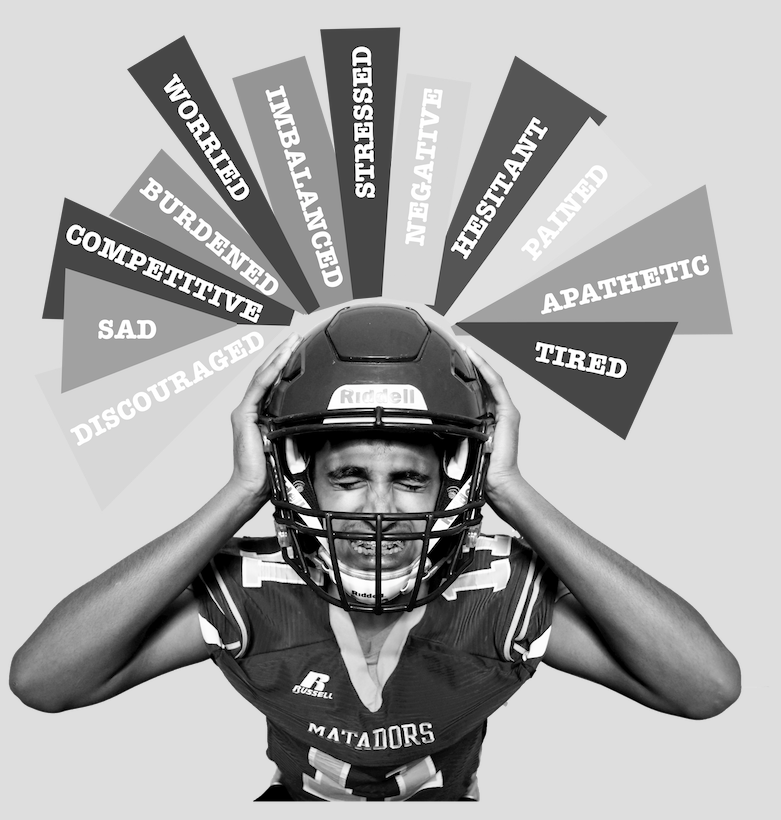
“When there’s too much emphasis on perfection and winning and not enough balanced emphasis on getting the full experience of getting closer to your teammates and the life experience of the enjoyment of sports, then [sports] can be super stressful,” Broder said.
Though winning is obviously a part of sports, Broder says athletes should also focus on the way they sport makes them feel — after all, the reason they play is because they enjoy it. Broder mentioned that athletes are encouraged to change their overall mindset so that it is easier for them to focus on the positives of life and not the negatives.
“Rather than focusing so much on ‘winning,’ it’s when they’re enjoying what they’re doing that they’re a lot more likely to be good at it,” Broder said. “Instead of focusing on what you are nervous about, focus on your goal, focus on already being there.”
To Gopalkrishnan, it’s that enjoyment of the game itself that will help improve an athlete’s mental well-being.
“When I play basketball, I just forget everything, especially school, and I just focus on [the game],” Gopalkrishnan said. “It helps free myself from all my schoolwork and I think that improves my mental health as well as my physical health — the process of getting in shape and becoming stronger makes me feel more confident in myself.”
Tennis Senior Night
October 31, 2018 • (Edit)
Senior Leslie Ligier shook her head as she heard her friends cheering her on. She looked back, smiled and wiped off some sweat. It was girls tennis senior night — one of the last times that Ligier would get to play on the MVHS tennis team. Ligier, along with the rest of the tennis team, had the main goal of maintaining its undefeated streak. From just simple rallies to competitive shots, Ligier explained how her game has improved from her first year of varsity to her last.
“In freshman year I was playing in my comfort zone, just getting the ball back,” Ligier said. “As the years progressed, I started playing a little bit more with my head instead of just with my physicality — I started playing a little bit smarter.”
The only other senior, Cynthia Hom, describes senior night and how much she has improved over the years as well. When she started playing varsity Hom was primarily a singles player, but as the years progressed she became a doubles player. She explains how her bond with her partner Brook Young has strengthened after they were paired up to play doubles together.
“I think over the years I’ve gotten a lot better at doubles in particular, because I focused more on doubles than singles, so now I’m probably better at doubles than singles,” Hom said. “I don’t know why we didn’t start playing together earlier, because our playing styles together just work really well. They make us a really good team.”
Being on the varsity team for four years, Ligier had a different feeling now that she was being celebrated.
“Especially my senior year, [being on the team] has probably been the best so far since we’ve had a lot more wins this year,” Ligier said. “And, it was just a lot more welcoming.”
Ligier expressed that her four years on the team lead to major improvements on her tennis gameplay, preparing for playing college tennis, which is the next step in her career.
“Playing competitive tennis is very individual, so I figured out how to train with other people, play on a team and become a team player,” Ligier said. “[This] is essential for college.”
Hom explained how she wishes to continue her career of tennis in college whether it be on the school team or a club. She noted that she is not actively getting recruited, but is still optimistic that she will not give up the sport once she reaches college.
“I’m not going to get recruited, but I’m hoping to walk on and wherever I go, play on the team,” Hom said. “Even if I don’t get on the division, like the varsity kind of team, in college, I hope to play club tennis.”
Similar to Hom, Ligier explained how much of an effect her teammates have had on her overall tennis career. Throughout her four years of varsity, Ligier shared that she has made some lifelong friends and if there is anything to remember the girls varsity tennis team by, one of the reasons would definitely be her teammates.
“I’ve made a lot of really great friends here that I’m never going to forget,” Ligier said. “[They] have give me countless amounts of advice and just — definitely the people [will be my biggest takeaway from this team].”
Hom described how much of an affect the team has had on her successes in tennis. She explained that the team has delivered support when it was most necessary and also brought many unforgettable friendships.
“I love the team community and the way that [we’re] all really close. I think that’s what makes it really a team,” Hom said. “I think my biggest takeaway is that with tennis, it’s the community aspect. It’s one of the most important parts of it.”
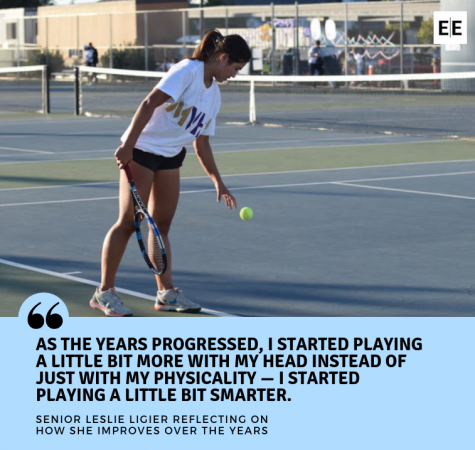
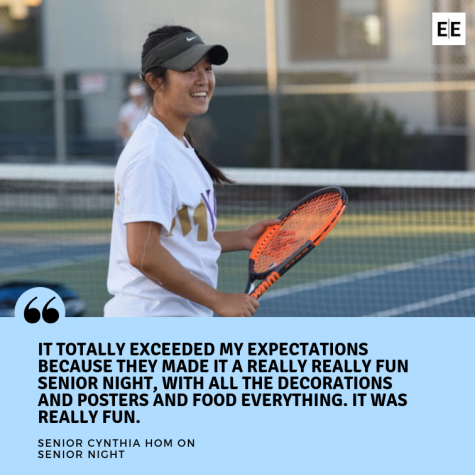
DOUBLED UP
He looked around the field, scouting the other players. He was nervous but confident, knowing that he had a strong chance of making the team. All he was waiting for was his name to be called. Time went on, his coach pulling players off the field, congratulating them. But he didn’t hear his name.
As nervousness and doubt ran through his mind, he finally heard those two words. As he rushed to the coach, the worry left his body. Though it was a year-long commitment, and he wouldn’t be able to play for his school team, he had made one of the top soccer teams in northern California.
Junior Brett Park plays competitive soccer for De Anza Force Academy U-17. Because of the high level of commitment required to play, athletes are required to sign a contract with the U.S. Soccer Development Academy (USSDA) that restricts them from playing for school. Due to the number of hours Park puts into his Academy team, he experiences difficulty balancing academics and club.
“I definitely use those three tutorials [and] sometimes I go in at lunch, but I definitely manage my time with planners,” Park said.
In addition to games and tournaments that span yearlong, Park participates in matches all over the world that he says negatively affect his academics.
“I’d say at least eight trips whether [that be] in state or out of state or in SoCal and then we had a trip to Spain,” Park said. “That ruined all my grades, it fell about five percent [in] each class.”
Park believes that though he made the decision to play for his club team, he misses out on the unique atmosphere that playing on a school team provides. Park admits that if there was no such contract between him and the USSDA, he would take the opportunity to play both.
“I see groups of people — football teams — and they have a real [brotherhood],” Park said. “I think it would be really fun, because I see all my friends play on the soccer team, but then I [remember that I] can’t.”
Although Park would like to be a part of a school team, he still recognizes the benefits of playing for the Academy, specifically the competitive environment that it offers him. Park hopes to continue his soccer career in college, and believes that playing for the school team would not give him the same kind of opportunities.
“I get a lot better because the Academy program is more competitive than at MVHS,” Park said. “I would rather get the college exposure from being a full-time academy player.”
Junior dancer Jana Tsai has also been exposed to a high level of competition that has taken a toll on her academics. She is a part of the MVHS dance team and a competitive team at NorCal Dance Arts, which takes her to competitions around the state and country.
Tsai explained the struggle of managing her time due to the workload of dancing for two teams. To make sure that she doesn’t fall behind in school, Tsai finds it necessary to communicate with her club and school coaches to ensure that her schedules will not overlap and create problems.
“I had to work out the conflicts that I’m going to have for the upcoming season because there [are] a lot of competitions during second semester that clash with the rehearsals that I have otherwise,” Tsai said.
Head coach of the MVHS boys varsity soccer team, Todd Kimble, explains how student athletes are not as committed to school sports as they are to club sports. He mentions that students do not put the time and effort required into school sports due to the academic environment at MVHS.
“The parents are paying [for their children to be in club teams], and you’re committed and the coaches wrap you into a commitment,” Kimble said. “Whereas in the high school sports, it’s much harder to wrap you into the commitment. Club comes first when it comes to soccer, however, grades come first even over that.”
Kimble explains that students have a different mentality when it comes to club sports and they become more focused and more determined, mainly because parents are playing for their children to play.
“It’s a way [they] approach it, ‘my parents are paying for it, my coach is demanding certain things’ and you are not with your buddies,” Kimble said. “There’s the mentality [that] ‘I’m going to go there to work.’ In high school, that’s where I think the difference is.”
Both Tsai and Park explain how much more competitive club sports are in comparison to school teams.
“I think the [MVHS team] is more focused on being a team and bonding, and it’s in school, so I feel like it’s not as intense or scary,” Tsai said. “When I’m with an outside dance group, my teachers are more focused on improving individuals [and] preparing them for potential careers as dancers.”
While Tsai acknowledges the intense environment that her academy brings, she still enjoys the team bonding activities with her school dance group during the season. With as much pressure and anxiety that comes with competing for a club, Tsai says this is something that the school can offer that her academy cannot.
“[The MVHS dance team] actually did specific activities, and I really liked it because I got to know the people I’d be dancing with at the at the camp that we went to over summer,” Tsai said.
In January of 2018, Tsai was also presented the opportunity to compete on NBC’s “World of Dance” with her academy dance team. On the show, competitive dance teams across the nation showcase their talents for a panel of judges. Tsai shared that she dedicated a lot of time to the show, including extra practices and rehearsals which took more time away from her school work.
“I think that the rehearsals leading up to going to the show were pretty stressful becauseour teacher she really wanted us to do well,” Tsai said.
Similar to Tsai’s experience on “World of Dance,” in March of 2017, Park went to Barcelona to play in the prestigious Mediterranean International Cup, where they faced teams ranging from Spain, Japan and Australia. His team won three games, tied one and lost the other in a penalty shootout, finishing 32 in the international tournament.
Regardless of the commitment an outside sports team requires, Park and Tsai still feel like the benefits outweigh the sacrifices that they continue to make to compete at the highest levels. For Park, playing in the Academy gives him a unique chance to pursue a collegiate career.
“I’m playing soccer right now a lot because it’s not only fun,” Park said. “It definitely gives me like a more of an opportunity to get into like colleges rather than just like my education alone.”
Coaching parents: Peter Wood on supporting your student athletes
On Sept. 25, parents of MVHS athletes trickled into the auditorium. All of them wanted to hear PAC, or the Parent Athlete Conference, representative Peter Wood share his thoughts about what role parents have in MVHS athletics. Throughout his presentation, he invited the parents to participate in various activities in order to help them understand the importance of communication. As the presentation went along, Wood talked about how its the parent’s job to support and encourage their child through difficult times.
“When kids see their parents crossover into a coaching mode, that relationship breaks down,” Wood said. “[A] child makes a mistake or loses the game or isn’t getting enough playing time, according to the parent, should not say a word, that is not their area.”
In most parent-athlete relationships, there is an over acting force that makes parents or supporters overly protective and that, in a way, can have a negative effect on a child. Wood said that it is better for a parent to give their child their space and only engage once the child is comfortable.
“When a parent acknowledges or identifies great teamwork, physical fitness, perseverance, bouncing back from mistakes, parents should [support] their child in those ways,” Wood said.
Athletic director Nick Bonacorsi believes that a parent has many different roles when it comes to supporting their child, but the biggest support that any parent can give is just simply watching them.
“Sometimes its parents that do not attend, [they] are not there to be a physical support,” Bonacorsi said. “As we build a different culture,the message gets to parents and [they understand] the significance of the role they play.”
Bonacorsi and Wood believe that it is the coaches responsibility to ensure that parents do not get in the way in their child’s athletic career.
“That’s certainly the coaches role. We tell them that in all our workshops, your job is to train the parent on how to be a sports parent,” Wood said.
From personal experience as well as studying the subject, Wood concluded that this type of coaching is effective and he is able to see the results. Wood believes that this coaching can improve the mental health of an athlete and grow the relationship between the athletes and their parents.
“When the coaches [are] coaching and the parent is parenting in the way that we talked about, we’re talking about happy fun kids,” Wood said.
Especially when it comes to school, there is pressure on a athletic and a academic level. It is necessary that parents be the support that will help them be successful in both athletics and academics.
“Our community does not know that we’re also highly successful athletically, compared to other schools that rank as high as we do academically,” Bonacorsi said. “There’s a lot of pressure on our athletes to do a lot, and that sometimes spreads them thin or gets in the way of their commitment.”
MVHS parent Saikat Saha believes that it is necessary for child athletes to enjoy the sport for them to manage it. Saha believes that sports teach children skills that will be needed later on in life.
“It really teaches you how to play in a team…when you go out after your school is over, teamwork is very essential in [a] workplace,” Saha said. “These are characteristics that will help you to succeed in the future. It’s really essential.”
Throughout the course of the presentation, Wood highlighted the importance of giving a child their space and how it is necessary it is to talk to children once they are ready to communicate. He emphasized the fact that most athletes do not wish to speak to their parents after their game and parents should respect that.
“When the coaches are coaching and the parents are playing their role, the kids are way happier, they have a lot more fun and the win losses don’t even play in with the feel and satisfaction of being on a team at that school,” Wood said.
Being a very enthusiastic parent, Saha believes that it is his responsibility to give his child space and not be emotionally invested in their sport. After the presentation, he understood what adverse effects that could have on a player and will try to limit his actions.
“One thing certainly I would like to avoid is to be critical, and analyze the game right after the game,” said Saha. “Coach Wood was talking about ‘self analyze’ and ‘self talk,’ I think this is really critical.”
From dream to reality
It was February 2016 and I was a freshman, eager to be joining the ranks of the MVHS volleyball team and donning the purple and gold. Throughout tryouts, I’d find myself gazing at the purple championship banners with gold embroidery. There was one there for every sport. Every sport except volleyball.
Fast forward two years, in February of 2018, I walked into the field house, saw varsity on one side and junior varsity on the other. I walked to the wall where I put my bag down and got my shoes on and began warming up. I look up and see countless number of banners commemorating individual teams for winning championships, but I searched for one particular banner. It was still missing.
The more I thought about it, the more I started to think about the last point of the 2017 CCS semi-finals against Bellarmine is still fresh in my mind and no matter how hard I try, I can’t unsee it. I still remember the last block that secured Bellarmine’s victory and our defeat, and the disappointment continues to wash over me.
As practices and league games flew by, we never worried. Soon it was time for the CCS championship, a purple banner waiting to happen.
Nervousness and uneasiness ran through my body as the day grew closer, but I was confident that we would be able to succeed, I juggled the anticipations of winning and losing.
By the fourth set both teams were worn out and tired. It was tied two sets to each team and it was time for the fifth. Bellarmine started to slip away, leaving us in the dust. With a score of 15-13, they became CCS champions.
Just like that, my hopes of seeing the championship banner disappeared. It was heartbreaking, emotionally devastating.
But the season wasn’t over. We had qualified for the NorCal championship by reaching the CCS finals. The stakes were much higher.
From February to May, many of our players faced injuries. I sustained an ankle and hamstring injury that kept me from playing for two weeks and it took me a while to fully recover. I never played to my full capacity. Knowing the number of injuries that we had, the thought of winning the championship seemed like a long shot.
Eleven days passed and it was time for the NorCal quarterfinals. “Monta Vista vs. Whitney, 1st round of NorCal championships, 5/22/18. Be there.” From Facebook posts to verbal advertising, we weren’t sure how many people would show — but in just 10 minutes the bleachers were packed. We knew these guys were huge, all above 6 feet and if they had made it this far then they had to be good.
The chances seemed minuscule, but we had hope, we had confidence and we trusted each other. We knew that their height was both their strength and their weakness, if they were tall that meant it is hard for them to play defense and we would have to take advantage of that.
“25-21, MVHS defeats Whitney in three straight sets and will now face Bellarmine in the NorCal semifinals.” The day finally came, another chance at victory over Bellarmine HS, our rivals for a couple years now.
I walked into the gym and saw the Bellarmine players warming up. It was intimidating but I knew how these guys played, I knew who their strong hitter was and how well he can perform in a competitive game and what he could do to our team. But we were prepared.
“Monta Vista defeats Bellarmine 15-8 in five sets and will advance to the NorCal finals.”
I still remember the first time I walked into the MVHS gym, I believed that we would never be able to play with the best teams. But in just 4 months, we were one of the best. I remember going back home and thinking about every play and being awestruck by what our team had accomplished.
9 a.m. on May 26: I woke up feeling both excited and nervous. This game meant everything to me and to my team. The pressure was on; the thought of winning gave me strength but the thought of losing gave me uneasiness.
At 2 p.m the referee blew her whistle and the game officially started. Both teams rallied point after point and neither team backed down. We started to gain momentum slowly but still lost the first set 25-20. We were nervous, but we knew that in a championship game anything could happen and we were ready. We fought back, and slowly we were able to stop their momentum and eventually took the second set 20-25.
The same continued for the next two sets, both teams rallied and both teams took another set and it came down to the fifth set. This was the decider. We had been in a fifth set situation before, but none was as big as this. Point after point, hit after hit, block after block, both teams started to tire down, but neither wanted to show it.
Clovis started going on a run, and soon enough they had the lead, 14-11 in the fifth set. The MVHS crowd had died down and the players morale had started to diminish. I thought this was the end, but there was still some hope in us and we started to fight back. We took it slow and suddenly the score was tied at 14-14.
There was a rush that we felt, a feeling that brought tears to my eyes and a smile across my face. They scored a point and it was 15-14, but we soon tied it up at 15-15. Now the game was even and the pressure was the highest it had ever been. We served the ball, hoping for an ace but instead what we got was even bigger, a block.
“One more point, one more point!” I kept hearing left and right.
“Monta Vista Matadors beat the Clovis Cougars 17-15 in the fifth set to be the 2018 NorCal Champions.”
Through the cheering and the excitement, I refrained from crying. This was a much bigger achievement, and I was speechless. I had waited seven years to play at such a level and for five of those, I had gotten absolutely nowhere and now suddenly I had become a champion. That night I could not sleep, I didn’t want to.
I started to think about what I have learnt from this season and the first thing that came to my mind was support. There had never been a time where my teammates had not supported me, through thick and thin. The more I thought about it, the more I realized that this was not a team, it was a brotherhood.
It has been four months and it still seems like it was a dream. With a new season ahead of us, I can already see myself walking into the gym, putting my bag down and tying on my shoe. But this time when I look up to the banners, there will be a purple banner with a gold embroidery saying the words that our team has been wanting to read for so long. In golden letters it will read “Boys Volleyball 2018 NorCal Champions.”
Make sure you read the actual story!







